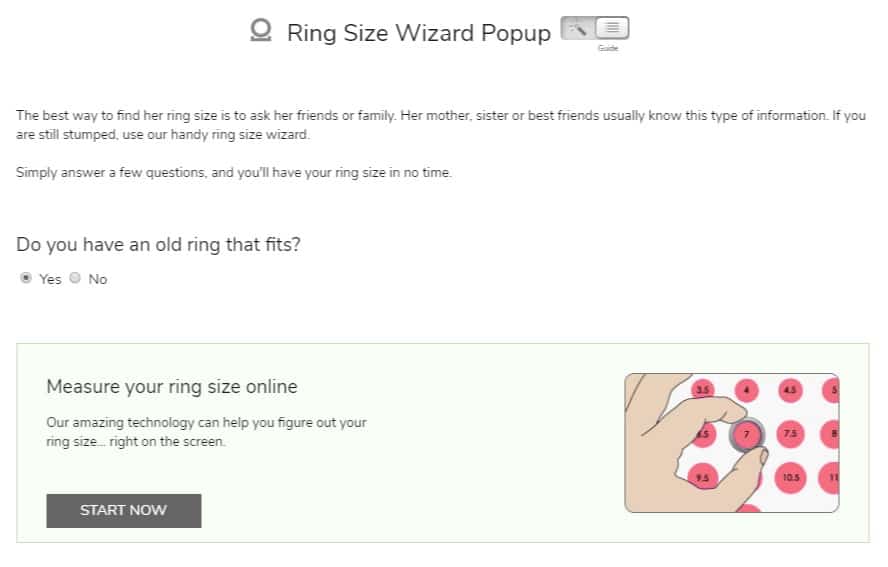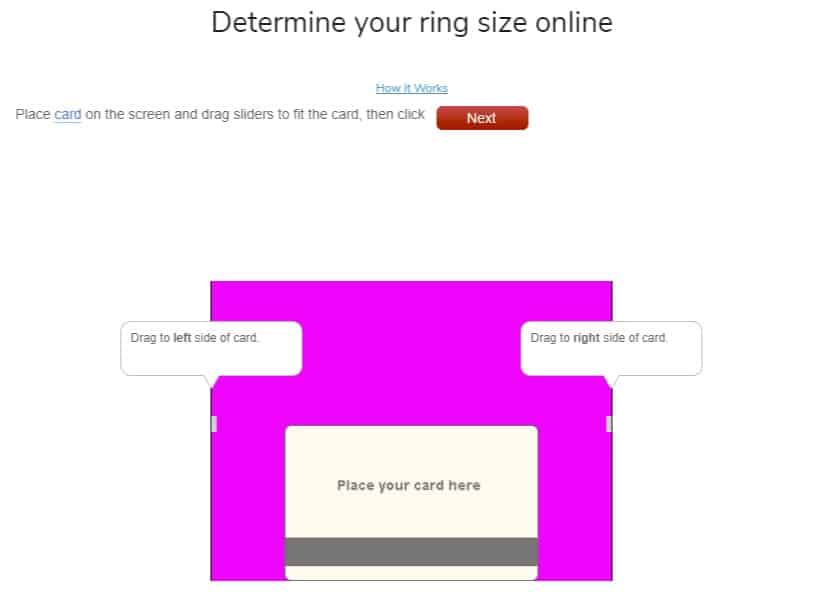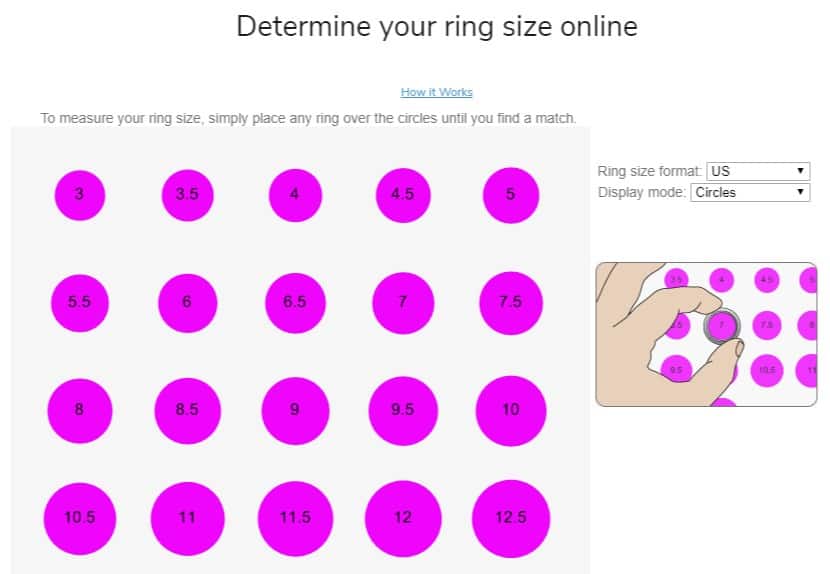I remember when I proposed to my lovely wife.
I was nervous, we were hiking to a summit that was nearly 10,000 feet, and I fought to catch my breath because the air was so thin up there. I was hiking with a massive pack that included our tent and other supplies because our plan was to spend the night at a nearby lake rather than return to the cabin.
And one of the heaviest things I was carrying was a diamond engagement ring.
It was in a side pocket on the hiking backpack, weighed just a few ounces, but it felt like twenty pounds.
When we reached the top, I proposed, she said yes, and I slipped the ring on… and it fit.
I knew she’d say yes. I wasn’t worried about that.
I was worried whether the ring would fit because you can’t exactly subtly ask “Hey honey, what’s your ring size? You know, the size of your wedding ring finger?” without giving something away. (if you really think that’ll work – go for it!)
But you still need the size, so how do you get it?
Table of Contents
The Best Way to Find a Ring Size
Besides asking because she (or he) already knows it, there are really only two good ways to find out a ring size:
- Find an existing ring and measure that ring. You know how it fits, whether it’s too loose or too tight, so it’ll give you a good indication of what your best size is. You can use an online ring sizer to measure the size or measure the diameter and calculate it (circumference = π x diameter, π = 3.14159).
- or, Measure the circumference of the finger you’ll wear the ring at the widest part. Use a string or even dental floss. Wrap it around your finger, make a mark, then measure the length of the string with a ruler.
You’ll want to know the circumference down to the millimeter.
If you don’t have access to string or floss, you can always print out a ring sizing guide from a site like James Allen. Print it out (make sure it’s regular size and not stretched to fit the page), cut it out, and wrap it around your finger as instructed.
When you measure your finger, do so when conditions are “normal.”
You don’t want to do it when it’s too warm, when you’ve been walking for a long time, or some other time when your finger could be slightly swollen. You don’t want to do it when you’re cold or dehydrated, as your finger could be slightly smaller. It sounds odd to say but there is a slight variation and you want to get a comfortable fit that isn’t too tight (uncomfortable) or too loose (likely to lose the ring).
You can also measure several times during the day to get an idea of how your fingers change over the course of a day.
Online Ring Sizer
Do you have a ring and don’t want to measure it? Use an online ring sizer.
The easiest one to use is this ring sizer from James Allen. Just click the button that says “Determine Your Ring Size Now.”

To make sure the size is correct based on your monitor’s resolution, you’ll need to get a credit card or driver’s license to size match. The floating “Place your card here” is NOT TO SCALE. You must get a card and move the left and right sides to match.

Next, find the ring and match it to a circle on the screen, sizes go from 3 to 16:

That’s it! Now all you need is to get an existing ring and you’re done.
Ring Size Chart
Here’s where it gets fun because ring sizes aren’t just a number in millimeters. And different countries use different size names.
The US and Canada use one system, usually from 3 – 13, while Great Britain uses letters.
The “Size in Millimeters” in the chart below refers to the circumference of your finger. You will see some charts that talk about the diameter – don’t use those charts. You have the circumference, why bother with the math? The circumference you have is what you want the inside circumference of the ring you want.
Here’s a ring size chart for you to convert size in millimeters into numbers and letters:
| Size in Millimeters | US / Canada | UK | Japan | France | Switzerland | Germany | |
|---|---|---|---|---|---|---|---|
| 44.1 | 3 | F | 4 | 44 | 4 | 14 | |
| 45.4 | 3 ½ | G | 5 | 45 ¼ | 5 ¼ | 14 ½ | |
| 46.7 | 4 | H ½ | 7 | 46 ½ | 6 ½ | 15 | |
| 48 | 4 ½ | I ½ | 8 | 47 3/4 | 7 3/4 | 15 ½ | |
| 49.2 | 5 | J ½ | 9 | 49 | 9 | 15 3/4 | |
| 50.5 | 5 ½ | K ½ | 10 | 50 ¼ | 10 ¼ | 16 ¼ | |
| 51.8 | 6 | L ½ | 12 | 51 ½ | 11 ½ | 16 ½ | |
| 53.1 | 6 ½ | M ½ | 13 | 52 3/4 | 12 3/4 | 17 | |
| 54.3 | 7 | O | 14 | 54 | 14 | 17 ¼ | |
| 55.6 | 7 ½ | P | 15 | 55 ¼ | 15 ¼ | 17 3/4 | |
| 56.9 | 8 | Q | 16 | 56 ½ | 16 ½ | 18 | |
| 58.2 | 8 ½ | R | 17 | 57 3/4 | 17 3/4 | 18 ½ | |
| 59.4 | 9 | S | 18 | 59 | 19 | 19 | |
| 60.7 | 9 ½ | — | 19 | 60 ¼ | 20 ¼ | 19 ½ | |
| 62 | 10 | T ½ | 20 | 61 ½ | 21 ½ | 20 | |
| 63.3 | 10 ½ | U ½ | 22 | 62 3/4 | 22 3/4 | 20 ½ | |
| 64.5 | 11 | V ½ | 23 | 64 | 24 | 20 3/4 | |
| 65.8 | 11 ½ | W ½ | 24 | 65 ¼ | 25 ¼ | 21 | |
| 67.1 | 12 | Y | 25 | 66 ½ | 26 ½ | 21 ¼ | |
| 68.3 | 12 ½ | Z | 26 | 67 3/4 | 27 3/4 | 21 3/4 | |
| 69.6 | 13 | — | 27 | 69 | 29 | 22 |
When in doubt, go slightly larger because slightly smaller risks the ring not fitting.
And if you do purchase a ring, get one that offers free resizing. Most online merchants will offer at least one free resizing in the first year. Both James Allen and Blue Nile offer one free resizing of an engagement ring within the first year. If you find that the ring is just slightly too small or just slightly too big, just take advantage of the free resizing to get a perfect fit.
How Much Is Resizing a Ring?
If you don’t get free resizing, or it’s been too long, getting a ring resized is not difficult. Most jewelers are able to resize a ring about two sizes either directly and the costs will vary.
If your ring is too big, and you need to resize it down, you’re in luck. This is the easier of the two resizes. It’s because they just need to remove a section of the ring, reconnect it, and you’re good to go. It’s often much cheaper because you don’t need new material, the jeweler will give you a bit of credit for the material (they keep it), and so the price will be lower.
If your ring is too small, and you need to resize it up, it’ll cost more because they need more material.
The biggest determinant to the cost of resizing is the material. Platinum is the most expensive, followed by white gold (because you need to replate it with rhodium too), then yellow gold, then sterling silver. Call your local jeweler to get a sense of how much it should cost. If you have stainless steel, tungsten, or titanium ring – sadly you are out of luck. Most jewelers are unable to work with them because of how hard they are. But call around to see.
Good luck!



